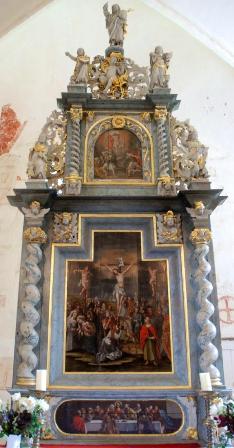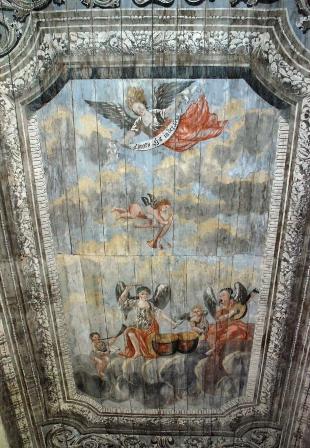The Church of Groß Bisdorf and its Baroque Interior
A short Introduction into the History of the 17th and 18th century
During the Thirty Years’ War from 1618-1648, Bogislav XIV, the last duke of Pomerania, governed with limited power and imperial troops of the Habsburg emperor Ferdinand II occupied his territory. In 1630, the Swedish king Gustavus Adolphus landed on the island of Usedom and forced Bogislav into an alliance against the Emperor. During this decade, Pomerania suffered from the garrisons of troops, violence and destruction. After Bogislav’s death in 1637 and negotiations for the peace of Westphalia 11 years later, the western part of Pomerania became Swedish. In the peace of Stockholm (1720), however, Sweden had to concede the territory South of the river Peene to Prussia.
A short History of its Construction
The church of Groß Bisdorf was built of bricks during in the 14th century as a hall church. The room, which is separated into three bays, is connected with a boulder made rectangular choir. This choir with a cross-ribbed-vault was already set up one century earlier. The northern aisle is connected to the sacristy, which was also made of boulders. The quadratic, brick made tower has a roof, which is constructed of copper and was renewed in 1791.
The Altar

The wooden, two-storey retable of Groß Bisdorf is adorned with three paintings. A depiction of The Last Supper is attached to the predella. This scenery is framed by some cherubs. Above this, there is a painting of the crucifixion group. Two winding, marbled Ionic columns are attached to its both sides. Beside the altarpiece of Christ’s ascension, are filigree Corinthian pillars located. In addition to this, the upper part of the altar is ornamented with lavished acanthus carvings. In front of it are the statues of the evangelists Saint Matthew and Saint John with their attributes. Additionally, two more statuaries of Saint Mark with his lion and Saint Luke with the bull are added to the following segment. The whole retable is crowned by a sculpture of Christ.
The Ceiling Painting

The nave, which is constructed with octagonal pillars, received a wooden ceiling with vaulting’s and an ornamental painting in 1723. This ceiling painting shows different music playing angels and others, who hold a banner with the quote “Ehfreü Gott in der Höhe”. This whole scenery is framed by floral ornaments and sumptuous acanthus elements. The aisles have profiled arcades and a boarded ceiling, which also was painted during the 18th century. This ornamental painting shows the fight of Jacob at the river Jabbok and Tobias with the archangel Raphael. This piece of art was discovered in 1994 during a restoration, because it had been covered with white paint in 1898.
Extravaganzas of the 17th and 18th century

A pulpit with certain elements of the Renaissance is attached to the eastern part of the church. This pulpit is adorned with frieze-elements. The curtain walling panels are decorated with paintings of different landscapes and festoons in a baroque style. The southern gallery, built during the 18th century, is ornamented with different emblematic pictures.
